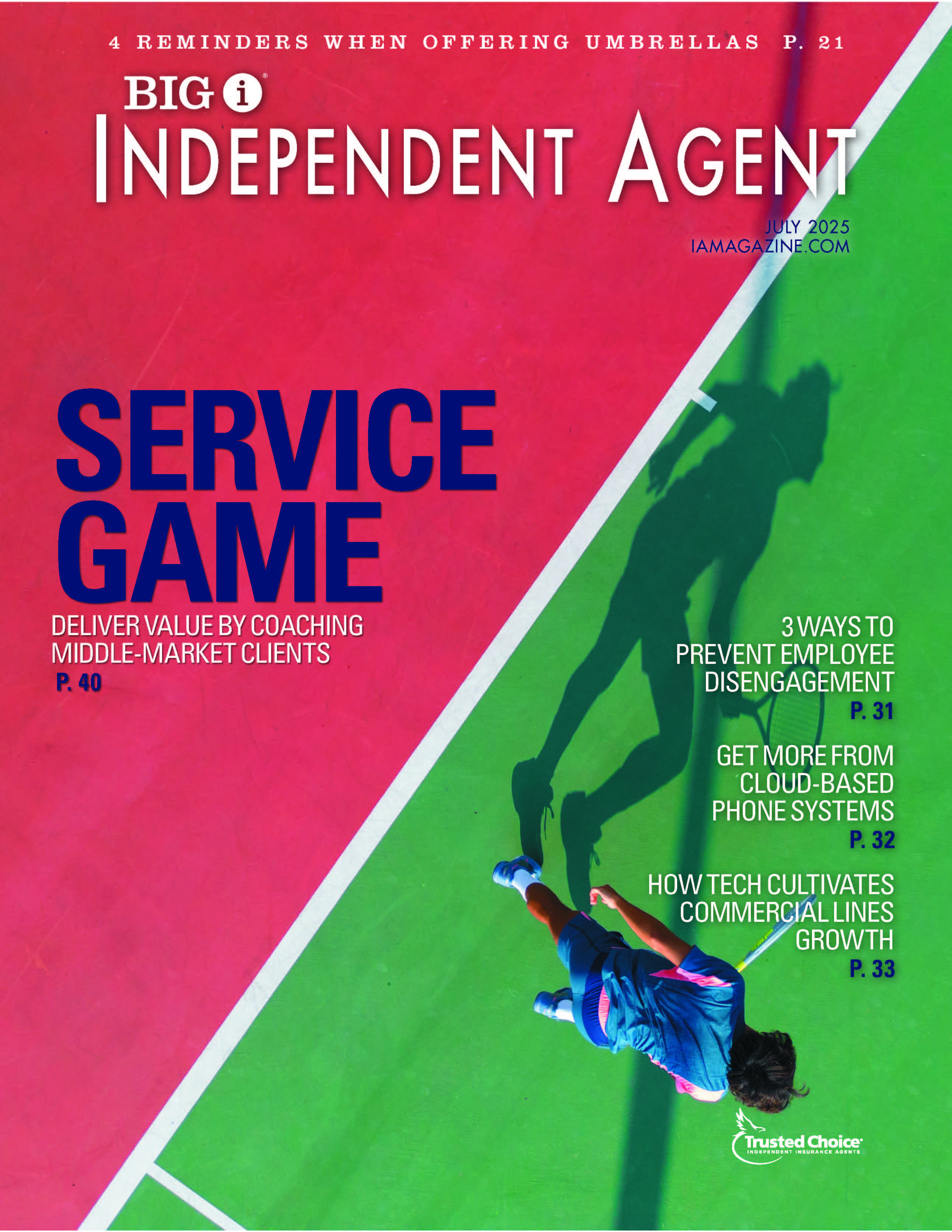4 Key Challenges Facing the Insurance Industry

By: Katie Butler
While organic growth has slowed, profitability remains steady at the top-performing- independent agencies in the country.
The new 2016 Best Practices Study, which provides benchmarks and analysis of the group of 260 Best Practices agencies, reveals how they are thriving in a difficult environment—and how all independent agencies can learn from their success strategies.
Every three years, the Big “I” collaborates with Reagan Consulting to select Best Practices firms throughout the nation for outstanding management and financial achievement in six revenue categories: less than $1.25 million; $1.25–2.5 million; $2.5–5 million; $5–10 million; $10–25 million; and more than $25 million. Big “I”-affiliated state associations and insurance companies nominate agencies, which then qualify based on operational excellence. The Best Practices program reviews financial and benchmarking information for the participating agencies and provides updates the following two years.
This year’s benchmarking analysis examines four key challenges facing the insurance brokerage industry:
Slowing growth. The average Best Practices firm grew organically by 6.9% in 2015, down from the recent high of 9% in 2012. For most Best Practices agencies, consistent organic growth—or non-acquisition growth—is the most important goal.
Sales velocity is a benchmark designed to measure the single most important driver of organic growth: new business. Defined as new commissions written as a percentage of a firm’s baseline (prior-year) commission and fees, sales velocity can create organic growth, even in a struggling marketplace.
Best Practices firms generate an average sales velocity of about 15%. This is well above the industry norm of approximately 12% and helps explain why Best Practices firms tend to outgrow the rest of the industry. How do Best Practices firms generate such high sales velocity?
1) They build a culture of accountability where salespeople must consistently produce significant new business at levels consistent with other Best Practices agencies.
2) They provide support structures and resources that enable producers to spend a large portion of their time generating new client relationships.
3) They consistently grow their production team by actively recruiting and developing additional salespeople.
Winning in a mature and crowded marketplace requires strategic clarity. The competitive landscape requires brokers to address several key questions:
- Who is our target client?
- What internal and external challenges drive the target client’s decision-making?
- How can our firm deliver unique and compelling value to the target client?
- Should we provide any specific resources to serve the target client’s needs?
- Can we recruit and train specific employees to focus their efforts on the target clients?
- Should we make any technology investments to better serve the target client?
- How does our firm maximize our exposure to target clients?
Although growth has slowed, Best Practices agencies find that specialization can create new revenue streams. Today, most Best Practices agencies derive a significant portion of their revenue from areas in which they specialize, because focused expertise can differentiate a firm in a crowded marketplace. For the largest firms, nearly half of revenue comes from specialty industries.
Increased consolidation. The consolidation pace has steadily increased since 2009, when merger & acquisition activity temporarily cooled in the wake of the Great Recession.
According to SNL Financial, 2015 was a record year for deal activity, marking 469 transactions. Why are so many agencies selling?
- Record valuations result from a record number of buyers, including publicly traded brokers, privately held agencies, banks and, most notably, private equity-backed buyers.
- Private equity’s entrance into the insurance distribution marketplace has been dramatic: Private equity firms have grown their share of deals from 4% to nearly 50% over the past decade.
- Increasingly, agency owners are concluding that size matters. As they feel the pressure to get larger as quickly as possible, some sell.
- The natural impulse to remain independent has, for some agencies, been thwarted by an inability or unwillingness to invest in the next generation of leadership and production. These firms are left with few alternatives but to sell.
- As client demands escalate, agents increasingly turn to third-party partners to provide access to the value-added tools and resources necessary to remain relevant.
Most agency shareholders face a dilemma created by this frothy market. Best Practices agencies address it by doing whatever it takes to close the gap between the lower internal agency value and the higher “street value.” The higher values delivered by third-party buyers typically result largely from expense reductions—producer compensation, owner compensation, staffing reductions—that the seller must agree to implement after closing the deal. Today’s agency owners recognize they can narrow the difference between internal and external value by getting more serious about making these changes on their own, without selling their business.
Another strategy the active M&A marketplace has produced is an offensive one. After years of believing they were priced out of the acquisition market, today’s Best Practices firms are jumping into the acquisition fray. They typically focus on smaller, local agencies owned by friends or respected competitors.
Finally, firms of all types and sizes recognize that in an environment dominated by consolidation, culture matters. Over the long run, a firm’s independence hinges on its ability to attract and retain talented employees. Most agencies today have an environment that works well for Baby Boomers and Gen X, but in the coming decade, the employment preferences of millennials and Gen Z will become increasingly important in shaping work environments.
Aging workforce. The average age of employees at most agencies has significantly increased. A workforce that is too heavily concentrated among any single age group will create a succession challenge if a large group retires within a small window of time.
Best Practices firms recognize the dual necessity of investing in talent and managing age concentrations to ensure stability in leadership, production and client servicing. Agencies best positioned to achieve long-term independence tend to employ generationally balanced production talent.
Many producers’ clients are heavily concentrated among their peer group. As producers approach retirement, decision makers at many of their clients may be doing the same. Regardless of whether or not the decision maker is on the verge of retirement, it is not unusual for a producer’s book of business to undergo a higher level of account attrition as they retire.
Because of this, many Best Practices agency leaders have developed plans and protocols for transitioning producer books when they retire. Typically, a firm must customize its “standard plan” to the needs and wishes of the retiring producer and those that will assume production responsibility for each account once they retire. These plans vary widely across the industry, but may include:
1) Requiring the producer to give a notification period prior to the transition.
2) Implementing a process for determining which producer(s) will assume production responsibility for each transitioning client going forward.
3) Developing a transitional compensation program that rewards both the incumbent producer and the new producer for the time and effort that will be required of each during the transition. Some plans, for example, split the normal producer commission between the two individuals, giving the majority to the retiring producer in the first year, splitting evenly in the second year and giving the majority to the replacement producer in the third. After the third year, all commissions go to the replacement producer.
Disruptive technology. New technologies may disrupt the traditional broker model. According to CB Insights, a firm that tracks technology investments in the insurance industry—dubbed “InsurTech”—the first half of 2016 marked 82 investments in insurance startups, totaling more than $1 billion.
These startups permeate every segment of the insurance industry. Best Practices agencies monitor InsurTech developments so they can effectively respond to emerging changes.
Two areas with above-average vulnerability are small commercial property-casualty and small group medical. Agency owners should know the percentage of business generated by these business segments. The smallest agencies have the highest concentrations of small accounts and are therefore generally more vulnerable to technology disruption than larger agencies.
Many firms focus on writing larger accounts with greater complexity. These types of accounts tend to benefit more from a broker’s involvement. But suddenly increasing an agency’s target client size is no small feat, especially for agencies outside large metro areas.
Wherever possible, agents must find ways to match or exceed the value proposition technology players offer, while retaining the all-important client relationship and risk management expertise that form the heart of the existing independent insurance industry.
This is the 24th edition of the annual Best Practices benchmarking analysis and the first year of the current three-year study cycle. The complete report is available for purchase as an e-book.
Compiled by Katie Butler, IA editor in chief, based on the 2016 Best Practices Study.










